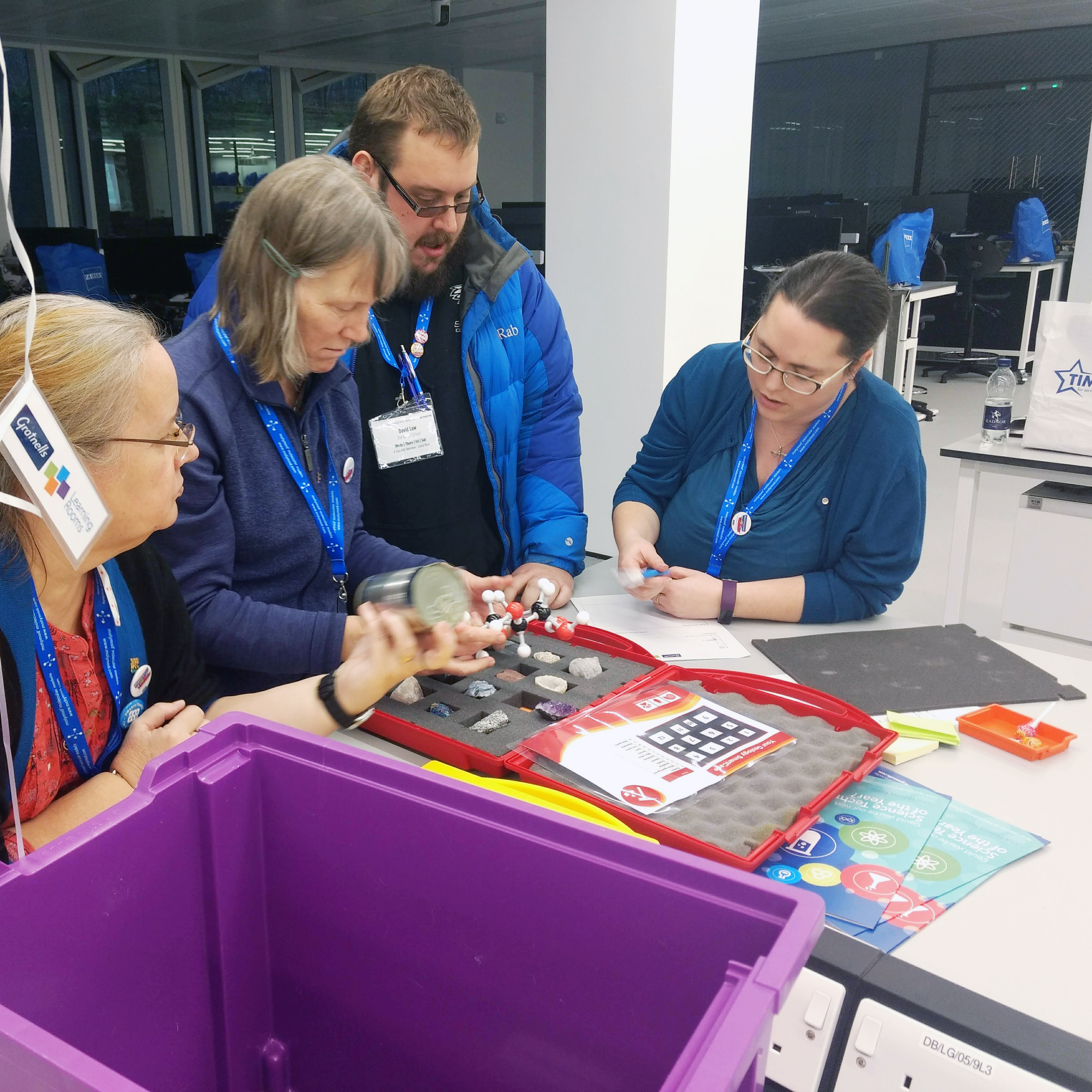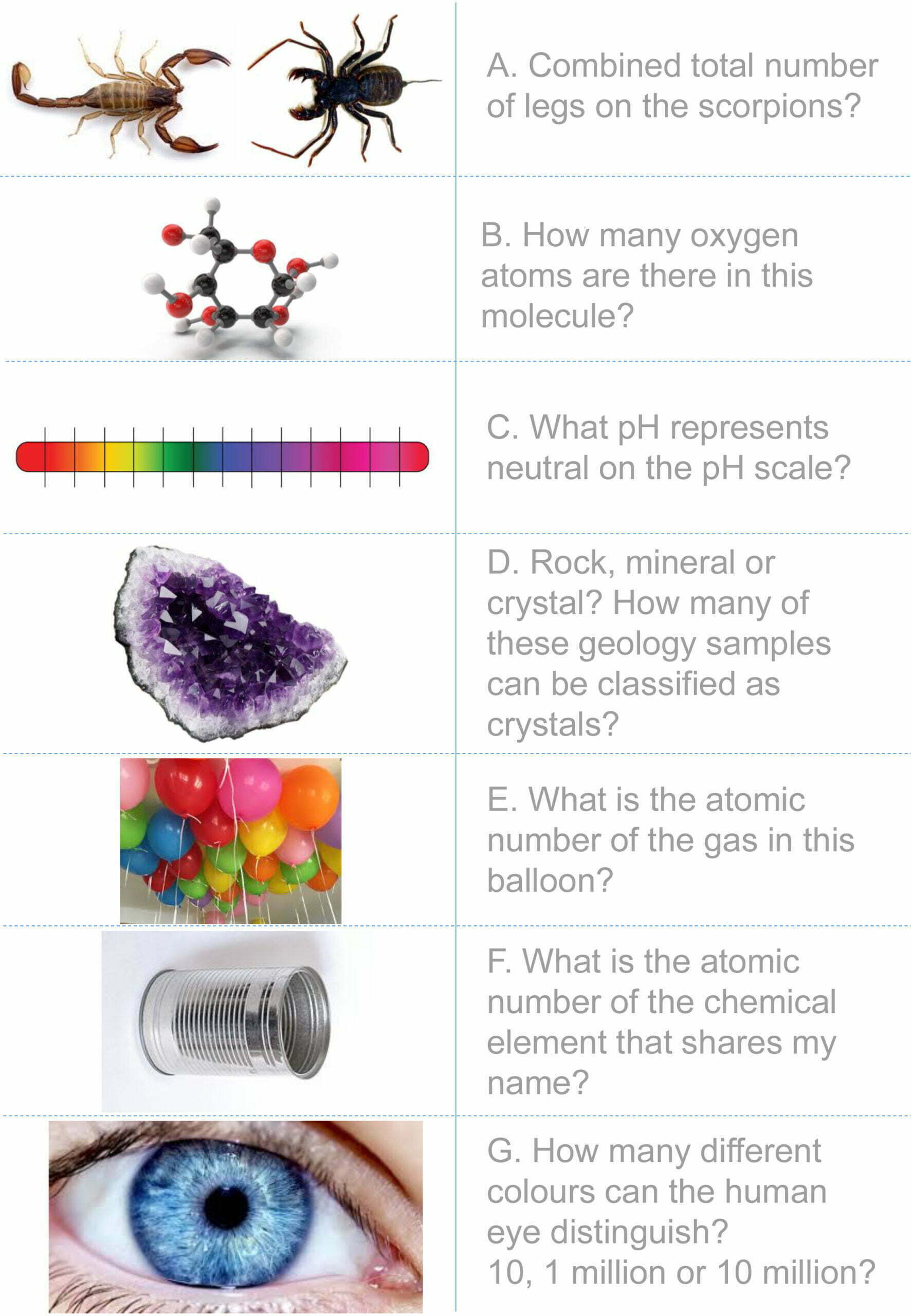Quiz #2
This activity was created as part of a Gratnells What’s In My Tray CPD workshop for secondary science teachers and technicians to support practical work and delivery of the curriculum. It can be carried out as a stand-alone activity for students or combined with other activities from the session to form a STEM carousel.

You will need (per team of 4):
- 1 x Jumbo Gratnells tray with lid
- Laminated question cards for all items
- Props related to each question:
- 1 x Natural Selection Learning minibeast SmartCase (A)
- 1 x Molymod set sufficient to build a glucose molecule (B)
- 1 x Picture of pH scale (provided) or a litmus paper test strip (C)
- 1 x Natural Selection Learning geology SmartCase (D)
- 1 x Small helium balloon with string and weight (E)
- 1 x Tin can with label taken off (F)
- 1 x Foam eyeball (G)
- A piece of paper and a pen/pencil
- Cleat tape, a colour printer, scissors and a laminator for set up use only.
Tip: If you don’t have some of the items on the equipment list, the second set of question cards provided show a photograph of the item and could be used alone, without a prop, for some of the questions. However, this is not possible for all questions. Your own selection of resin encapsulated minibeasts (should include two scorpions) could be used in place of the Natural Selection Learning minibeast SmartCase. Your own selection of rocks, minerals and crystals (should include four crystals) could be used in place of the Natural Selection Learning SmartCase.
This activity also works for individuals or smaller teams, just increase the amount of time allocated to complete it. Once prepared, this activity can be repeated multiple times, reusing the same equipment for each team.
Preparation:
- Make a glucose molecule out of molymod.
- Print and cut out the question cards <hyperlink to download> by cutting along the dotted lines and folding along the solid lines.
- Laminate the question cards and fix each one to their corresponding prop with transparent tape.
- Place all the labelled items into the jumbo tray and put the lid on. Stack the SmartCases on top.
What to do:
- Approach the tray and lift the lid.
- Read the question cards attached to the props and those on the outside of the SmartCases.
- Explore the contents of the tray and the SmartCases and answer each of the questions (A to G).
- Substitute each answer into this equation: (A + B + C + D + F + G) x E = ?
- Make a note of each answer A to E, your workings and the answer to the equation.
- For an additional bonus point – identify molecule B and note down its name.
Tidy up time:
Put everything back into its original tray or SmartCase, close the SmartCases and replace the tray lid.
When all participants have completed the activity, swap papers with the next team and mark the answers. The activity leader will put the correct answers up on the screen or call them out.
Answers:
- Total number of legs on the scorpions = 2 x 8 = 16
- Number of oxygen atoms in this molecule = 6
- pH that represents neutral on the pH scale = 7
- Number of samples that can be classified as crystals = 4
- Atomic number of the gas in the balloon = helium = 2
- Atomic number that shares my name = tin = 50
- The number of colours the human eye can distinguish = 10 million
Total of (A + B + C + D + F + G) x E = 20 million 166 or 20,000,166
Molecule B = Glucose or C6H12O6
1 point per correct line. Total of 9 points available.
Other things to try…
- Have a go at our original Quiz What’s In My Tray
- Substitute any of the items and questions for ones you have invented yourself. Use this to tailor the activity to the age and ability of your pupils or your current areas of study. Just be sure to adjust the final calculation and answer accordingly. Depending on the age and ability of the pupils, or if you make the calculation more difficult, you may need to provide a calculator.
- Challenge the students to work in pairs or small teams to create their own quiz trays, either open ended or based on a current topic, e.g. the periodic table. Upon completion, the trays can be rotated around the class for everyone to have a go at.
- Take photographs of your quiz trays and share them on social media using #WhatsInMyTray.
Health & Safety
As with all Gratnells Learning Rooms What’s In My Tray activities, you should carry out your own risk assessment prior to undertaking any of the activities or demonstrations.


